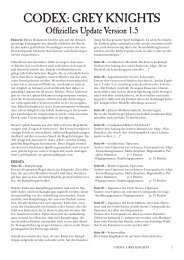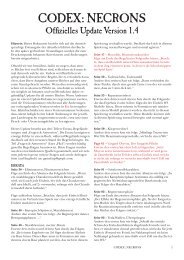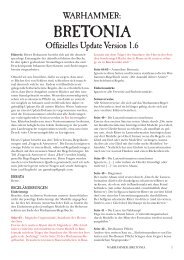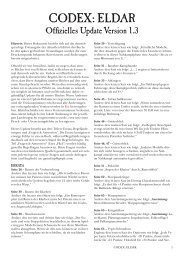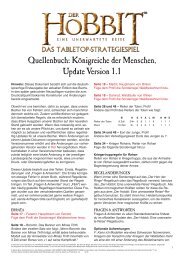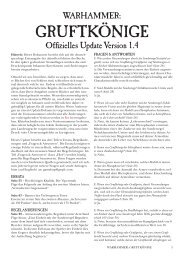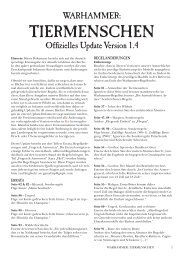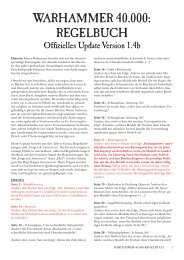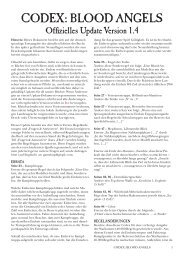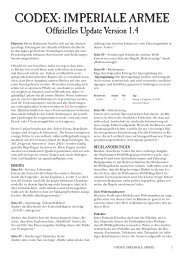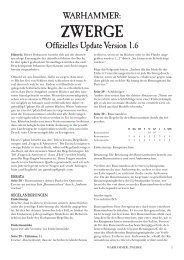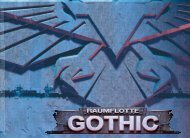Necromunda rulebook - Games Workshop
Necromunda rulebook - Games Workshop
Necromunda rulebook - Games Workshop
You also want an ePaper? Increase the reach of your titles
YUMPU automatically turns print PDFs into web optimized ePapers that Google loves.
SHOOTING AT A<br />
FIGHTER WHO IS DOWN<br />
You do not have to shoot at a target who is down<br />
even if it is the closest target. However, you can shoot<br />
at a fighter who is down if you want to and he is the<br />
closest or easiest shot. You can... If you’re really that<br />
mean. You are... Read on!<br />
If a fighter who is already down takes a further<br />
wound or wounds, roll again on the Injury table and<br />
apply the result. A flesh wound will inflict further<br />
WS/BS penalties. If the fighter goes down again then<br />
ignore the result. If he goes out of action remove the<br />
model from combat.<br />
Generally speaking, it is rare for players to shoot at<br />
enemy fighters who are down unless they are<br />
stranded in the open and there are no other targets<br />
available. However, it sometimes happens that blast<br />
weapons scatter from their point of aim and<br />
accidentally hit men who are already down.<br />
BLAST WEAPONS<br />
Some weapons fire an exploding shell or energy blast<br />
which inflicts damage over a large area. The spread of<br />
a shot or blast is represented by a circular blast<br />
template.<br />
When you shoot a weapon that uses a blast marker<br />
nominate your target and roll to hit exactly as you<br />
would with any other weapon. If the target lies<br />
beyond the weapon’s range then the shot dissipates<br />
harmlessly causing no damage. Otherwise take the<br />
blast marker and proceed as follows.<br />
If you hit the target place the blast marker with its<br />
centre directly over the target model. The target is<br />
hit, and any other model that lies wholly inside the<br />
blast marker is hit too. If a model lies partially within<br />
the blast marker then it is hit on a further D6 roll of<br />
a 4, 5 or 6. Roll for wounds and injuries on each<br />
model that is hit.<br />
If you miss the original target then your shot has<br />
flown wild but may still land close enough to cause<br />
damage. To determine where the shot has landed you<br />
must make a Scatter roll. To do this you will require<br />
the two special dice, the Scatter dice (marked with<br />
arrows and a hit symbol) and the Artillery dice<br />
(marked with numbers and a ‘!’ symbol). Take both<br />
these dice and roll them so that they land as close to<br />
the target as possible.<br />
19<br />
NECROMUNDA<br />
If the Artillery dice shows a number this indicates<br />
how far you have missed the target by – 2", 4", 6", 8"<br />
or 10". The direction in which the shot lands is<br />
indicated by the scatter dice arrow. Note that the Hit<br />
symbol also has an arrow marked on it, so it can be<br />
used to indicate direction. Place the marker in the<br />
position indicated by the two dice.<br />
If the Artillery dice shows a misfire then the shot<br />
dissipates in the air or is a dud and has no effect.<br />
If the dice show a Hit and Misfire then the shell may<br />
have exploded in the breach as explained in the rules<br />
for Exploding Weapons (see Exploding Weapons in<br />
the Advanced Game Rules section).<br />
Once the marker is positioned any models that lie<br />
wholly under the blast marker are hit. Any models<br />
which lie partially under the blast marker on hit on<br />
the further D6 roll of a 4, 5 or 6. Work out the effect<br />
of hits normally.<br />
The new target is<br />
partially within the<br />
blast marker and is<br />
therefore hit on a D6<br />
roll of a 4, 5 or 6.<br />
The Artillery dice rolls a<br />
‘4’ and the Scatter dice<br />
rolls an arrow symbol.<br />
The Orlock fires his gun at an<br />
Goliath 8” away. He misses and<br />
must therefore roll the scatter<br />
and artillery dice to determine<br />
where the shot lands. He rolls a 4<br />
on the artillery dice, indicating<br />
that the blast marker is moved 4”<br />
in the direction of the arrow on<br />
the scatter dice.<br />
Note that no shot can ever scatter by more than half<br />
the range between the shooter and their target. If the<br />
target is 10" away, for example, the miss may not<br />
scatter by more than 5" regardless of the dice score.<br />
However, a wildly scattering shot may land outside its<br />
usual fire arc (90 degrees in front of the firer) or<br />
beyond its usual maximum range.<br />
8”



